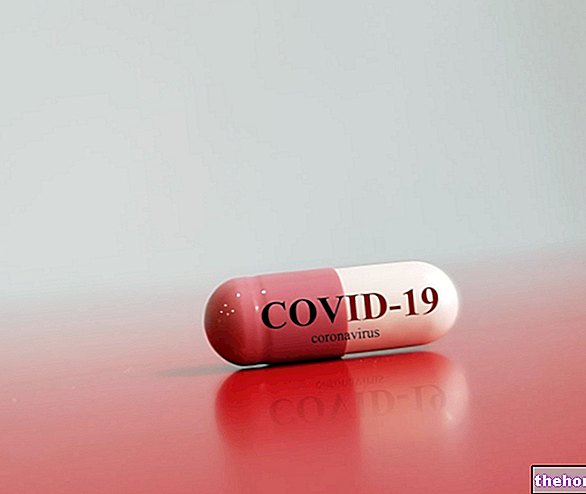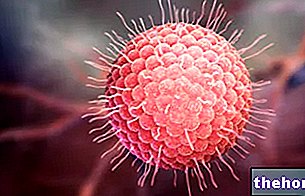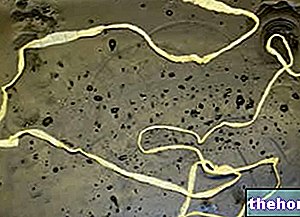Introduction
Gram-negative are bacteria that - after undergoing the Gram staining technique - take on a color ranging from pink to red.

Bacterial cell wall
The bacterial cell wall can be defined as a rigid structure that encloses the bacterial cell giving it a certain strength and conditioning its shape.
The fundamental element that constitutes the bacterial cell wall is the peptidoglycan (otherwise known as bacterial mucopeptide or murein).
Peptidoglycan is a polymer consisting of long linear polysaccharide chains, joined together by cross-links between amino acid residues.
Polysaccharide chains are composed of the repetition of a disaccharide, which in turn consists of two monosaccharides: the N-acetylglucosamine (or NAG) and acid N-acetylmuramic (or NAM), linked together by β-1,6 glycosidic bonds.
The disaccharides are then linked to each other with β-1,4 type glycosidic bonds.
Linked to each molecule of NAM we find a "tail" of five amino acids (a pentapeptide) ending with two equal amino acids, more precisely, with two molecules of D-Alanine.
It is precisely these terminal D-Alanine molecules that - following the action of the transpeptidase enzyme - allow the formation of cross-links between the parallel chains of the peptidoglycan.
More specifically, the transpeptidase originates a peptide bond between the third amino acid of a polysaccharide chain and the fourth amino acid of the parallel polysaccharide chain.

Cell wall functions
The bacterial cell wall plays a very important protective role towards the bacterial cell, but not only that, it is also able to regulate the transport of substances inside the cell itself.
Therefore, it can be said that the main functions of the cell wall are:
- Prevent breakdown of bacterial cells due to osmotic pressure. In fact, very often, bacteria live in hypotonic environments, that is, in environments where large quantities of water are present and which are "more diluted" than the internal environment of the bacterial cell. This difference in concentration causes the water pass from the external environment (less concentrated) to the inside of the bacterial cell (more concentrated) in an attempt to equalize the concentration between the two environments. The uncontrolled entry of water would cause the bacterial cell to swell until it burst (osmotic lysis).
The function of the cell wall is precisely that of resisting the external pressure of water, thus preventing swelling and bacterial lysis. - Protect the plasma membrane and the cellular environment from molecules or substances harmful to the bacteria itself.
- Regulate the entry of nutrients into the bacterial cell.
Everything that has been described so far is valid both for the cell wall of Gram-negative and for the cell wall of Gram-positive.
However, since the purpose of this article is to provide information on the characteristics of Gram-negative bacteria, only the cell wall of the latter will be described below and that of Gram-positive bacteria will not be considered.
Gram-negative cell wall
In the Gram-negative wall, the peptide bond that forms between the polysaccharide chains of the peptidoglycan is direct.
The cell wall of Gram-negative is very thin and has a thickness of 10 nm, but it is quite complex, since the peptidoglycan is surrounded by an outer membrane anchored to it.
The outer membrane consists of an internal phospholipid-type sheet and an external sheet formed by lipopolysaccharide (or LPS).
The outer membrane and the peptidoglycan are connected to each other through lipoproteins. Since the presence of only lipoproteins on the outer membrane would hinder the passage of hydrophilic molecules, other particular protein complexes are also present on the membrane. porine. Porins are channels that allow the passage of small hydrophilic molecules.

For the transport of larger molecules, on the other hand, other transport proteins are present, i carriers.
The space present between the outer membrane and the peptidoglycan is called periplasm and contains proteins and enzymes with biological functions.
The lipopolysaccharide is replaced by three distinct parts:
- An internal lipid part called lipid A which has endotoxin functions, therefore it plays an important role in the pathogenicity of Gram-negative;
- A central polysaccharide portion called core;
- An external polysaccharide chain called antigen O. This polysaccharide is made up of simple sugars of various kinds, gathered in blocks of three or five units and repeated several times to form molecules with certain antigenic characteristics typical of each bacterial species.
Gram stain
Gram staining is a procedure devised and developed in 1884 by the Danish bacteriologist Hans Christian Gram.
The first step of this procedure involves the preparation of a smear (ie a thin film of the material to be analyzed) fixed by heat. In other words, a sample of the bacteria to be analyzed is placed on a slide and - through the use of heat - the microorganisms are killed and blocked on the slide itself (hot fixation). After preparing the smear, you can proceed with the actual staining.
The Gram stain technique has four main steps.
Phase 1
The heat-fixed smear should be coated with the dye crystal violet (also known as gentian violet) for three minutes.By doing this, all the bacterial cells will turn purple.
Phase 2
At this point, la Lugol's solution (an aqueous solution of iodine and potassium iodide, defined as a mordant, since it is able to fix the color) and is left to act for about a minute.
Lugol's solution is polar and penetrates the bacterial cell where it meets the crystal violet with which it forms a hydrophobic complex.
Phase 3
The slide is washed with a bleach (usually alcohol or acetone) for about twenty seconds. After that, it is washed with water to stop the action of the bleaching agent.
At the end of this phase, the Gram-positive bacteria cells will have retained the purple color.
The Gram-negative cells, on the other hand, will have discolored. This happens because the alcohol attacks the lipopolysaccharide structure of the outer membrane of these bacteria, thus facilitating the loss of the previously absorbed dye.
Phase 4
A second dye is added to the slide (usually, acid fuchsin or safranin) and let it act for a couple of minutes.
At the end of this phase, the previously discolored Gram-negative bacteria cells will take on a color ranging from pink to red.
Types of Gram-negative bacteria
Like the Gram-positive group, the Gram-negative group also includes numerous bacterial species.
Below, some of the main bacteria belonging to this group will be briefly illustrated.
Escherichia coli
L"E. coli it is a bacteria normally present in the human intestinal bacterial flora, but in immunosuppressed subjects it can give rise to opportunistic infections.
Indeed, E. coli it is responsible for opportunistic infections that cause pathologies such as urethrocystitis, prostatitis, neonatal meningitis, enterohemorrhagic colitis, watery diarrhea or traveler's diarrhea or sepsis.
Depending on the type of infection that E. coli triggers, different types of antibiotics can be used. The most commonly used drugs are carbapenems, some penicillins, monobactams, aminoglycosides, cephalosporins or macrolides (such as clarithromycin or azithromycin).
Bacteria belonging to the genus Salmonella
These bacteria are responsible for gastrointestinal tract infections which can cause diseases such as gastroenteritis, typhus (enteric fever) and diarrhea.
Ciprofloxacin, amoxicillin or ceftriaxone is usually used to fight infections caused by these bacteria.
Klebsiella pneumoniae
There K. pneumoniae it is responsible for genitourinary tract infections that cause cystitis, prostatitis or urethrocystitis and respiratory tract infections that cause lung abscesses or pneumonia.
For the treatment of infections with K. pneumoniae cephalosporins, carbapenems, fluoroquinolones or some types of penicillins are used.
Bacteria belonging to the genus Shigella
These microorganisms are responsible for the onset of diseases such as bacillary dysentery and acute gastroenteritis.
Fluoroquinolones are usually used to treat this type of infection.
Vibrions (or Vibrio)
Vibrions are curved bacilli, ie bacteria characterized by a "comma" shape.
Among the pathogenic vibrions for man, we remember:
- Vibrio cholerae, responsible for the onset of cholera. Generally, infections from V. cholerae they are treated with tetracyclines or fluoroquinolones.
- Vibrio parahaemolyticus, responsible for gastroenteritis, enterocolitis, diarrhea and dysenteric-like syndrome.
In case of infection with V. parahaemolyticus antibiotics such as fluoroquinolones or tetracyclines can be used. In some cases, antibiotic therapy can be avoided and symptomatic treatment can be proceeded with.
Bacteria belonging to the genus Yersinia
Bacteria of the genus Yersinia are bacilli, that is, they are bacteria characterized by a cylindrical shape.
Among the pathogenic Yersinia for man, we remember:
- Yersinia enterocolitica, responsible for the "onset of" gastrointestinal infections that cause diseases such as acute gastroenteritis or mesenteric adenitis. Y. enterocolitica they are usually treated with antibiotics such as fluoroquinolones, sulfonamides or aminoglycosides.
- Yersinia pestis, responsible for the onset of the bubonic plague. Infections caused by Y. pestis they can be treated with aminoglycosides, chloramphenicol or fluoroquinolones.
Campylobacter jejuni
The C. jejuni it is a spiral bacillus responsible for the onset of acute enteritis and diarrhea.
The infections caused by him can be treated with macrolides (such as, for example, erythromycin) or with fluoroquinolones.
Helicobacter pylori
H. pylori it is a curved bacillus responsible for the onset of gastrointestinal diseases such as chronic active gastritis and peptic ulcer.
Treatment for the "eradication of"Helicobacter pylori provides for the use of three different types of drugs:
- Colloidal bismuth, a cytoprotective used to prevent the adhesion of Helicobacter pylori to the gastric mucosa;
- Omeprazole or another proton pump inhibitor to reduce stomach acid secretion;
- Amoxicillin and / or clarithromycin, tetracyclines or metronidazole (antibiotic drugs to kill bacterial cells).
Haemophilus influenzae
H. influenzae is a Gram-negative bacterium responsible for respiratory tract and nervous system infections that can cause acute otitis, epiglottitis, sinusitis, bronchitis, pneumonia or acute bacterial meningitis.
Antibiotics commonly used to treat infections from H. influenzae they are cephalosporins, penicillins or sulfonamides.
Legionella pneumophila
There L. pneumophila is a Gram-negative bacterium responsible for legionellosis, an "infection that affects the" respiratory system.
Legionellosis can be treated with drugs such as azithromycin, erythromycin, clarithromycin, telithromycin or fluoroquinolones.
















.jpg)











